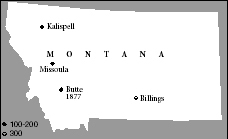Montana
By Bernard Postal and Michael Berenbaum
Montana is one of the Rocky Mountain states of the United States. The Jewish population is 1,495.

Jewish communities in Montana and dates of establishment.
According to one observer, Montana’s Jews tend to fall into three categories: remnants of the pioneer community still in Helena or Butte; out-of-state professionals who mass in university towns such as Bozeman or Missoula; the lone Jew who lives in Townsend or Ennis or Miles City. The community is united by the Montana Association of Jewish Communities (MAJCO).
Member communities include Aitz Chaim (Great Falls Jewish Community), Bet Harim (Flathead Valley Jewish Community), Beth Aaron (Billings Jewish Community), Beth Shalom (Bozeman Jewish Community), Har Shalom (Missoula Jewish Community), and B’nai Israel (Butte Jewish Community). MAJCO regularly holds a shabbaton in the spring of each year. Chabad has sent summer rabbis to work with the community and is planning a full-time rabbinic presence in Bozeman, perhaps the liveliest of the Jewish communities.
The first Jews, who arrived in 1862 during the gold rush at Bannock and Virginia City, were miners, wagon drivers, merchants, freighters, hotel and saloon keepers, lawyers, and journalists, many of whom became solid citizens in the raucous mining camps. Ben Ezekiel was chief clerk of the first territorial legislature and Jacob Feldberg was a member of Virginia City’s first town council. Jews were also among the leaders of the vigilantes who suppressed outlawry.
The oldest Jewish settlement dates from 1864, with the arrival of Jewish merchants in Helena. One of the pioneers was Gumpertz Goldberg, for whose wife Helena is said to have been named.
The First Hebrew Benevolent Society, organized in 1865, became the nucleus for Temple Emanu-El, founded in 1887; their synagogue, the state’s first synagogue, was built in 1891. When the Jewish community declined in the 1920s, the synagogue was deeded to the state, and it now houses the State Department of Public Welfare.
When Butte became the biggest city in the state following the silver and gold booms around Anaconda in the 1870s, most of the early Jewish settlers and the later arrivals settled there. There was a Jewish congregation, Beth Israel, in Butte in 1877. It split over ritual in 1897 and a second one came into being, but today there is only one congregation with a synagogue dating from 1904.
Long before Montana became a state in 1889, its Jewish residents were counted among its leading citizens. Henry Jacobs was Butte’s first mayor in 1879, and Henry Lupin held that office from 1885 to 1889. Charles S. Cohan, editor of The Butte Miner, wrote the words for the state song. One of the early cattlemen was Louis Kaufman, who employed the cowboy artist Charlie Russell. Between 1873 and 1906, four Jews were grand masters of the State Masonic Grand Lodge: Sol Star, Moses Morris, H. Sol Hepner, and Henry I. Frank, a former mayor of Butte. Livingston, Great Falls, and Havre also had Jewish mayors before 1900.
Among the colorful figures in the early days of the state were Daniel Bandman, a Shakespearean actor who brought theater to the mining camps (Bandman’s Bridge outside Missoula is named for him); Moses Solomon, a Buffalo hunter and Indian fighter; and Philip Deidesheimer, a mining superintendent, who invented the square set system of mining timbers and for whom Philipsburg is named. The Bob Marshall Wilderness Area of 950,000 acres in the Flathead National Forest is named for the son of Louis Marshall, who was chief of the division of recreation in the U.S. Forest Service.
The story of Billings, Montana, tells much about the paradox of Jewish life in Montana. In 1993, Billings had a population of 48 Jewish families among 81,000 residents. Hate literature appeared in mailboxes; the synagogue was painted with a swastika along with a picture of a Jew being shot by Einsatzgruppen, tombstones were overturned, Holocaust denial literature was circulated, and the homes of two Jewish families including the symphony conductor, which had been adorned with menorahs, had their windows broken. A cinder block was thrown through a Jewish child’s window. The local Church Council and the senior minister of the First Congregational Church passed out menorahs to his congregation. He put a menorah in his own window. The newspaper printed a full page cutout of a menorah. The chief of police characterized the response: It became physically impossible for the hate group to harass and intimidate thousands and thousand of Billings’ citizens … We have spoken one very loud voice.
In this case, the response to hatred was a united chorus of solidarity. The specific motif of the Holocaust, which was the threat of the hate groups, was embraced by the community to say, We will behave differently.
Hatred will not triumph. The Jews will not be isolated but embraced. It was a hopeful moment for all concerned that spawned the Not in Our Town movement. The group was launched in 1995 with the PBS film, Not In Our Town, about the heroic efforts of the citizens of Billings.
Helena was one of only four state capitals without a synagogue or Jewish center. That changed in 2022, when the Jewish community purchased a synagogue built 130 years ago to use as a community and cultural center for Jews in the state. There is no plan to hire a rabbi or use Temple Emanu-El, which was built in 1891, as a synagogue.
BIBLIOGRAPHY
B. Kelson, "The Jews of Montana" (thesis, University of Montana, 1950); B. Postal and L. Koppman, A Jewish Tourist’s Guide to the U.S. (1954), 281–9. ADD. BIBLIOGRAPHY: E. Linenthal, Preserving Memory: the Struggle to Create America’s Holocaust Museum (1995).
Sources: Encyclopaedia Judaica. © 2007 The Gale Group. All Rights Reserved.
Not In Our Town.
Montana Jewish Project buys Helena temple built in 1891,
AP, (August 25, 2022).


